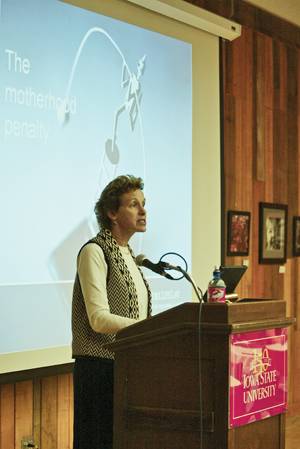The ideal of a working adult is changing

Joan Williams gives a lecture on work and family conflict in the Pioneer Room of the Memorial Union on Thursday, Oct. 9, 2008. Williams is a Distinguished Professor at Hastings Law School, University of California and is the author of the book, “Unbending Gender: Why Family and Work Conflict and What to Do About It”. Photo: Elena Noll/ Iowa State Daily
October 9, 2008
The norm of married, with two-and-a-half kids, a dog and white picket fence may not be the “norm” anymore. Work may become top priority, said Joan C. Williams, distinguished professor of law at the University of California.
The definition of the “ideal worker norm” was explored during a lecture Thursday about how family and work conflict and what to do about those stressful issues.
“The ideal worker norm is really someone who starts to work in early adulthood and works full time, full force, for forty years straight, taking no time off for child bearing or really anything else,” Williams said.
Over the years, the idea of this “norm” has changed drastically. It is no longer viewed as what is was during the nineteenth century, or even during the 1950s.
“You can live up to the ideal worker norm by having a family form that models and designs around it, which is a man married to a woman,” Williams said. “Then you can start to work in your early adulthood and not take any time off because you, basically, out-sourced most of the childcare and much of the rest of your life.”
The workforce is changing and people are finding out that the norm may be categorized as “old-fashioned.”
“The problem is that that’s not the workforce anymore,” Williams said. “It was the workforce when the ideal of professors was invented in the nineteenth century or even earlier when the academic procession started out. It’s clear that a monk can be an ideal worker. He can work however long he wants to and can move wherever he needs to work, but that is not our workforce today. It’s an issue where you have this old-fashioned ideal worker norm which perfectly fits the work force of the 1950s, but it does not fit the work force of today.”
Williams discussed how with this ideal worker norm, people can no longer chase their careers to various places around the country or world as they once were able to. Their families prevent them from doing so, as they have obligations and often choose to put their family first.
“Often where family conflict, most of the time, is actually defined as an internal psychological problem,” Williams said. “It’s important to recognize what that comes from — it really comes from a clash of social ideals. You start out with that ideal worker norm, and that clashes. The simplest way is to say that it clashes with a little hang up that most of us have — that children need and deserve time with their parents.”
Williams said these problems of juggling family and work often lead to problems and internal conflict.
“When you have those kinds of ideals, it quickly turns into a personal issue of internal conflict, ‘I feel so torn,’ ‘I feel like I’m not doing anything right,’ ‘It just isn’t working,’” she said.
Women and men are often faced with the decision of whether or not to pursue their career, or stay at home and raise their family. Different trade-offs are made with each gender.
“Women tend to make trade-offs on the work side. Men tend to make trade-offs on family,” Williams said. “Women are not expected to be ideal workers, but men are.”
From a student’s point-of-view, work and family can cause conflict as well.
Katie Thilges, sophomore in biology, worked at Panera Bread this past summer. Throughout the summer, she had to deal with balancing work and family time.
“I didn’t get to see my family as much as I would like to,” said Thilges.
She explained how her family always spends time together during the holidays, but she did not get to spend as much time with them as she would have liked due to her conflicting work schedule.
“It was hard because my family spends a lot of time together during the holidays, and I had to work then,” Thilges said.






